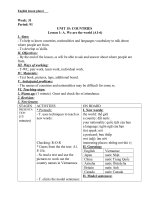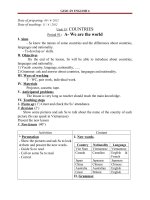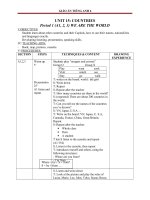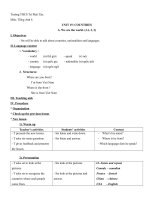Giáo án Tiếng Anh 8 unit 15: Computers
Bạn đang xem bản rút gọn của tài liệu. Xem và tải ngay bản đầy đủ của tài liệu tại đây (150.66 KB, 16 trang )
UNIT 15: COMPUTERS
LESSON 1 – GETTING STARTED, LISTEN AND READ.
A. Aim: By the end of the lesson, Ss will be able to express their opinions about a problem.
B. Methods: Communicative approach
C. Teaching aids:
Teacher: textbook, poster, pictures
Students: textbook, notebook, pens, rulers.
D. Procedure:
I. Class management: 1 minute
II. Revision: (5 minutes) WARM-UP
III. New lesson:
1. Setting the scene: Included in the WARM-UP
2. Main activities:
Teacher’s and students’ activities
On the board
WARM-UP
- Ask Ss to say out the functions of the Brainstorming
computers.
Computers can help us:
- Write on the board
- save time
- listen to music
- learn interestingly
- play games
- keeping information
- getting information
PRE-READING
I. Vocabulary:
- a printer (picture): máy in
- Present new words and then guide Ss to
read them in chorus
- a manual (realia): sách hướng dẫn
- Check vocabulary by technique “Bingo”
- (to) connect (hand gesture): kết nối
- Get Ss to copy.
- under guarantee (situation): bảo hành
- (to) unplug (mime)
Checking technique: Bingo.
II. True / false prediction:
- Set the scene: “Nam and his father, Mr.
Nhat are talking about the problem of the
computer they’ve just bought. What
happens to the computer?”
- Have Ss guess which statements are true
and which are false.
- Give feedback.
1. The printer isn’t working
2. Nam has already turned the printer on
3. Nam knows how to connect a printer but he
hasn’t connected it correctly
4. The manual helps them to find out the
problem of the printer
5. Mr. Nhat bought the printer in HCM city and
it’s still under guarantee.
6. Mr. Nhat thinks the company wouldn’t do
anything with his printer because it’s too far
from his place.
WHILE-READING
III. True-False checking
Answer key:
- Ask Ss to read the dialogue on page 138
and check their guessing.
1. True
2. True
3. False- Nam knows how to connect a printer
and he has connected it properly.
4. False- Mr. Nhat thinks it isn’t very helpful.
5. True
6. Mr. Nhat thinks the company should do
something with it.
IV. Reading comprehension:
Answer key:
a) Fact
b) Opinion
c) Opinion
d) Fact
e) Fact
- Explain the words: “ Fact and Opinion”
2
+ Fact: a thing that is known to be true,
especially when it can be proved
f) Opinion
+ Opinion: Your feelings or thoughts
about someone of something, rather
than a fact.
- Get Ss to read the statements and check
the suitable boxes.
POST-READING
VI. Write it up
- Call on some Ss to give their answers
- Give feedback and correct.
- Ask Ss to use reported speech to rewrite
the dialogue.
- Divide the class into 3 groups and assign
each group to report about 3- 4 sentences.
- Have them write their report on a poster
and put it on the board for public check.
IV. Consolidation: (2 minutes)
- T asks students to state the main points of the dialogue.
V. Homework
- Write the reported speech into your notebooks
- Prepare Speak + Listen
PERIOD 96
UNIT 15: COMPUTERS
LESSON 2 – SPEAK
A. Aim: By the end of the lesson, Ss will be able to use some common useful expressions to
express agreement and disagreement.
B. Methods: Communicative approach
C. Teaching aids:
Teacher: textbook, poster, pictures
3
Students: textbook, notebook, pens, rulers.
D. Procedure:
I. Class management: 1 minute
II. Revision: (5 minutes) WARM-UP
III. New lesson:
1. Setting the scene: Included in the WARM-UP
2. Main activities:
Teacher’s and students’ activities
On the board
WARM-UP
- Ask Ss each to think of one of the ways
computers are helpful and write it on a
piece of paper.
Guessing game: “Do you think that...?”
- Call on a student to the front of the class.
- Get the rest of the class ask him/ her “Do
you think that computers are ............?”
PRE-SPEAKING
- Present new words and then guide Ss to
read them in chorus
I. Vocabulary:
- Check vocabulary by technique “Slap the
board”
= (waste time)
- Get Ss to copy.
- time-consuming (a) (explanation)
- challenging (a) (translation)
- degree (n) (translation)
- amusing (a) (synonym)
= funny
- (to) adjust (translation)
- Write the topic on the board: Useful
expressions to express agreement and
disagreement.
- Put the table on the board and elicit Ss’
answers then write them in the table.
Checking technique: Slap the board
II. Brainstorming:
Useful expressions to express agreement and
disagreement.
Opinion
Agreement
4
I like....
So do I
I don’t like...
I agree
I think...
You’re right
I feel....
Neither do I
I don’t believe..
- Ask Ss to read the dialogue on page 138
and check their guessing.
Degree of agreement
Disagreement
I agree, but.....
I disagree
Yes, but on the other
hand.....
I can’t agree with you
No I think....
- Put the photocopied pictures/p139 on the
right of the board and the words cues on
the left (not in order)
WHILE-SPEAKING
- Ask Ss to match the words with the
III. Matching
pictures
A. Reading comic books
d. £
- Call on some Ss to go to the board to
B. Playing in the rain
a. £
draw the matching lines
C. Driving a car
b. £
D Foreign food
c. £
Answer key: A - b
B-c
C-a
-d
- Get a student to demonstrate the model
(a)
- Ask Ss to use the adjectives in the box
/p140 to express their opinions after going
through the meaning of some new words
- Ask Ss to use the pictures on the board to
practice speaking with their partners
- Call on some pairs to demonstrate for the
class
- Give feedback and correct
D
IV. Picture drill (Oral drill)
T: I think driving a car is easy
P: I disagree. I think it’s difficult to drive a car or so
do I
1/ entertaining
2/ time - consuming
3/ challenging
Suggestions:
a. Driving a car
- Easy once we get used
to it
Learning to drive a
car
- Challenging/ difficult to
get used to driving in
traffic
- Dangerous
b. Comic books
- Boring
5
Reading comic
books
- Interesting/ fun
c. Playing in the rain
- Fun
- Time-consuming
- interesting
- Entertaining
d. Foreign food
Hamburgers, pizza,
French fries
- Delicious
- Fun to cat
- Unhealthy
POST-SPEAKING
- Ask Students to write full dialogues in
VI. Write it up
their notebooks.
IV. Consolidation: (2 minutes)
- T asks students to state the main structures of agreement and disagreement.
V. Homework
- Do exercise 1,2 in workbook
- Prepare Read
PERIOD 97
UNIT 15: COMPUTERS
LESSON 3 – READ
A. Aim: By the end of the lesson, students will know more about how computers work in a
university.
B. Methods: Communicative approach
C. Teaching aids:
Teacher: textbook, poster, pictures
Students: textbook, notebook, pens, rulers.
D. Procedure:
6
I. Class management: 1 minute
II. Revision: (5 minutes) WARM-UP
III. New lesson:
1. Setting the scene: Included in the WARM-UP
2. Main activities:
Teacher’s and students’ activities
On the board
WARM-UP
Brainstorming: Advantages of computers
- Ask Ss to work in 2 teams, each team
takes turns to write the benefits of
computers on TV.
- Monitor and correct
Suggested answers:
- watching TV
- reading newspapers
- playing games
- listening to music
- ...
- Present new words and then guide Ss to
read them in chorus
- Check vocabulary by technique “What
and where”
PRE-READING
I. Vocabulary:
- Freshman (n) (explanation)
= the first - year student at a college/university
- Elicit words from ss and write them inside
- Jack (n) (realia)
circles
- Get Ss to repeat and rub out the word, not
the circle.
- bulletin board = notice board (picture)
- Continue until the circles are empty.
= not believe in something
- Get Ss to repeat the rubbed - out circles
by pointing at the empty circles.
- impact (n):
- skeptical (adj) (explanation)
(translation)
- a campus (explanation)
- Have Ss fill in the circles on the board
with the right words again (5 Ss at a time)- = the yard and garden of the university.
Get Ss to copy.
- (to) access (translation)
7
- (to) store (translation)
- Introduce the topic of the text
- Ask Ss to guess what they're going to
read.
- Write the Ss' guesses on the board
- Ask Ss to read the text to check if their
guesses are correct or not
Checking technique: What and where
II. Open prediction
* Suggested questions:
1. Where in the library do we get / find
information?
2. How can we store the information?
- Get Ss to read the text again then read the
true/false statements and decide if the
statements are true or false.
- Call on some ss to give their answers and
correct the false statements
- Have Ss copy all the right statements in
their notebooks.
3. If we want to discuss something, how can we do?
WHILE-READING
III. True/False Statements
Answer key:
a-T b-T c-T d-F e-T f -T
- Have Ss read the questions/p. 142 and
find the information in the text to answer
d. (Student don't have to go to computer rooms
because college campuses now have computer jacks
in every part of the university)
- Ask Ss to compare their answer with their
partners
IV. Comprehension questions
- Call on some Ss to give their answers for
the class
- Give feed back and correct
Answer Key:
a) It has no library. All the information normally
found in a library is now stored in the university's
computers.
b) All the information normally found in a library
or messages normally found on a bulletin board.
c) A computer and a telephone (line)
d) With a bulletin board on the Internet, a great
number of people (over 20 million) can get access
to the bulletin and exchange information quickly.
- Students read the passage again and
e) Student's answers.
summarize it.
POST-READING
- Call some students to summarize in front
8
of the class.
VI. Retell the story
- Monitor and correct.
IV. Consolidation: (2 minutes)
- T asks students to state the points of the passage.
V. Homework
- Write the answers of part IV in your notebooks and do the exercises 3 & 4 in the workbook
- Prepare Write and Listen
PERIOD 98
UNIT 15: COMPUTERS
LESSON 4 – WRITE + LISTEN
A. Aim: By the end of the lesson, students will be able to write a set of instructions on how to use
the printer to complete a flow chart and listen to the text about procedure of an automatic Soda
machine to complete a chart
B. Methods: Communicative approach
C. Teaching aids:
Teacher: textbook, poster, pictures
Students: textbook, notebook, pens, rulers.
D. Procedure:
I. Class management: 1 minute
II. Revision: (5 minutes) WARM-UP
III. New lesson:
1. Setting the scene: Included in the WARM-UP
2. Main activities:
Teacher’s and students’ activities
On the board
WARM-UP
- Ask Ss to work in 2 teams and play the Play game: Shark's attack.
game.
9
- Ask Ss the meaning of the word
PRINTER
- Expected answers: Máy in
_______
Key word: Printer
PRE-WRITING
I. Vocabulary:
- Present new words and then guide Ss to
read them in chorus
- Check vocabulary by technique “Slap the
board”
- Get Ss to copy.
- paper input tray (n) (picture)
- power button (n) (picture)
- icon (n) (picture)
- output path (n) (picture)
- remove (v) = to put (s.th) away
- (to) insert (translation)
- a starting point (n) (translation)
- a coin (picture)
- (to) press (mime)
- Ask Ss to look at exercise 1/p. 142 and do
the matching
Checking technique: Slap the board
- Get some Ss to give their answers and
correct.
Answer Key
II. Matching
a-3 b-1 c-6 d-2 e-4 f-5
- Get Ss to make sure of some phrasal
verbs.
WHILE-WRITING
III. Gap fill
- Put the words on the board and ask Ss to
fill in the gaps with the right words if
possible.
1 (to) wait .... (so / s.th)
- Ask some Ss to give their answers and
correct.
3 (to) turn .... (a machine)
2 (to) remove .... (s.th)
4 (to) plug .... (s.th)
5 (to) load ...... (s.th)
Answer Key:
10
1. (to) wait for(so / sth)
2. (to) remove (sth)
3. (to) turn on/off (a machine)
4. (to) plug in(sth)
5. (to) load (sth)
- Ask Ss to look at the pictures/p. 143 and
read the cues.
- Have Ss work in pairs to outline the
instructions.
- Call on some Ss to say out the
instructions first.
- Ask Ss to write the instructions in their
notebooks.
IV. Write the instructions:
Answer Key:
+ Plug in the printer and turn on the power.
+ Remove the old paper and load the new paper in
the paper input tray.
+ Wait for the power button to flash.
+ Have the pages appear on the computer screen
- Have some Ss read their writing before
the class.
+ Click the printer icon on the screen and wait for a
few seconds.
- Give feedback and correct.
+ The printed paper will come out of the output
path in a minute.
- Ask Ss to look at the flow chart and guess
the words in the gaps
- Play the tape (2 or 3 times) and ask Ss to
listen
- Tell Ss to fill the gaps with the
information they have heard from the tape
- Have Ss compare the answers with their
partners
- Give feedback and correct
- Have Ss write a set of instructions on how
to get a drink from a machine, using the
flow chart.
POST-WRITING
VI. Listen and fill in the flow chart
Answer Key:
a. Do you have the correct change?
b. yes
c. What do you want to drink?
d. take it
IV. Consolidation: (2 minutes)
- T asks students to summarize the flow chart
V. Homework
11
- Have Ss write a set of instructions on how to get a drink from a machine, using the flow chart.
- Prepare Language Focus 1, 2
PERIOD 99
UNIT 15: COMPUTERS
LESSON 5 – LANGUAGE FOCUS 1, 2
A. Aim: By the end of the lesson, students will be able to use "yet" and "already" to express the
present perfect.
B. Methods: Communicative approach
C. Teaching aids:
Teacher: textbook, poster, pictures
Students: textbook, notebook, pens, rulers.
D. Procedure:
I. Class management: 1 minute
II. Revision: (5 minutes) WARM-UP
III. New lesson:
1. Setting the scene: Included in the WARM-UP
2. Main activities:
Teacher’s and students’ activities
On the board
PRESENTATION
- Present new words and then guide Ss to
read them in chorus
- Check vocabulary by technique “ROR”
I. Vocabulary:
- (to) depart (translation)
Checking technique: Rub out and remember.
- Get Ss to copy.
II. Presenting the grammatical points:
Set the scene: "Ba's mother has just been
back from market. She wanted him to do
some housework while she was at the
market. Ba made notes in his diary and
check the work he has done. Look at Ba's
Model sentences:
T: Has Ba done his homework yet?
S: Yes, he has already done his homework.
12
diary"
T: Has Ba tidied the room yet?
- Show the chart (Ba's diary) on the board.
S: No, he hasn't tidied the room yet.
- Ask questions and elicit the answers from
Ss.
*Concept Check:
- Have Ss repeat and write the sentences on
the board.
Present perfect with yet and already.
* Use: Yet: used in question and negative
statements.
Already: used in positive statements.
* Positions: Yet: at the end of the sentence.
- Ask Ss to look at Ba's diary and complete
the dialogue using Yet and Already.
Already: between auxiliary have and past participle,
at the end of the sentences.
- Call on some pairs to demonstrate the
dialogue for the class.
- Give feedback and correct.
PRACTICE
III. Gap-Fill Dialogue.
Answer key:
I have finished it already;
- Ask Ss to look at the flight information
tables and ask questions to show the
models.
- Ask Ss to talk turn to ask and answer the
questions.
- Call on some Ss to demonstrate the
exchanges in front of the class.
- Give feedback and correct.
- Open pairs
- Closed pairs
I haven’t cleaned and tidied it yet;
I have already turned it off;
I’ve already called and told her to have lunch with
us
IV. Language focus 2: (p. 144-145) Question and
answer:
T: Has the flight to Vientiane departed yet?
S: Yes, it has already departed.
T: Has the flight from los Angeles arrived yet?
S: No, it hasn't arrived yet.
- Call some students to read aloud their
works for the whole class to comment.
13
- Feedback
PRODUCTION
V. Make sentences:
- Make 5 sentences with YET and 5 with
ALREADY
IV. Consolidation: (2 minutes)
- T asks students to state the main use of YET and ALREADY
V. Homework
- Prepare Language Focus 3, 4
PERIOD 100
UNIT 15: COMPUTERS
LESSON 6 – LANGUAGE FOCUS 3, 4
A. Aim: By the end of the lesson, students will be able to compare the present perfect and past
simple.
B. Methods: Communicative approach
C. Teaching aids:
Teacher: textbook, poster, pictures
Students: textbook, notebook, pens, rulers.
D. Procedure:
I. Class management: 1 minute
II. Revision: (5 minutes) WARM-UP
III. New lesson:
1. Setting the scene: Included in the WARM-UP
2. Main activities:
Teacher’s and students’ activities
- Call a student to the board to revise the
last lesson
On the board
REVISION
Yet and already: - Usage and meaning
- Give example.
14
PRESENTATION
Set the scene:
I. Presenting the structure
* Use Vietnamese to elicit the models
Model sentence:
a. I've ever been to Dalat .(finished)
b. My parents have gone to Dalat for 3 days
(incomplete)
*Concept check: present perfect tense.
Use: finished actions - indefinite time
- incomplete actions - for, since, recently
Form: have / has + past participle.
II. Grammar drill.
- Ask Ss to look at the table p/146, read the Answer key:
sentences and check (v) the correct column.
a-c-e-f
- Call on some Ss to give their answers.
b-d-g
- Give feedback and correct.
(are finished action)
(are incomplete action)
PRACTICE
- Put the chart on the board and ask Ss to
read the sentences.
- Ask Ss to decide which sentence is in the
present perfect and which is past simple.
III. Presenting present perfect and past simple:
Revision.
Model sentences:
a. Her family moved to Ha Noi 2 years ago.
b. My brother has become more independent since
he left home.
Use:
1: Past simple - finished action with definite time.
2: Present perfect - an action (not) taking place
from the past to the present.
- Ask Ss to complete the dialogues/p. 146
orally.
IV. Grammar Drill.
1. Have seen; did see;
saw
15
- Call on some pairs to give their answers.
- Give feedback and correct.
2. haven’t had
3. Have been
4. Have heard
5. happened
6. had
7. fell
8. broke
9. Has arrived; has; did arrive; arrived
PRODUCTION
V. Exercises in workbook
- Make 5 sentences with YET and 5 with
ALREADY
- Students do all the exercises in the
workbook
IV. Consolidation: (2 minutes)
- T asks students to compare PRESENT PERFECT and SIMPLE PAST
V. Homework
- Prepare Getting started, listen and read
16









